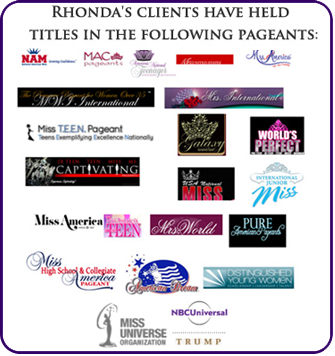Natural Pageants
Pageant systems that fall under this category are National American Miss (NAM), Miss American Coed Pageant (MAC), America’s National Teenager (ANTSO), Cinderella, America’s Outstanding Teen, Miss America, Miss USA, Mrs. America, Mrs. United States and Mrs. International. There are many more but this is a sampling of nationally familiar systems within the pageant world.
- Generally speaking, the makeup guideline for children under 12 is zero. Some will allow only mascara and lip gloss on stage under the bright light. Makeup used on teens and women is to enhance the natural beauty, not to become the focal point or to make them look like someone they’re not. The same goes for hairstyle. Always make sure to check with your director about the specifics for your pageant.
- Clothing is tasteful and has sparkle to it; but is not overly ornate. Wardrobe is usually purchased off the rack at a store and subtly embellished or customized by the contestant to reflect their sense of personality and style. The wardrobe is to always bring attention back to the girl wearing it. Not the other way around.
- Modeling style for gown is elegant and smooth. Arms and hands are close to your body moving in natural opposition (when you step forward with your right foot, your left arm is moving forward and so forth). For fun fashion or casual wear modeling, the style is more upbeat than in formal wear and has a runway feel; but elaborate routines and stunts are not appropriate.
- Facial expressions are natural with the energy of the eyes and smile matching.
- Communication skills are developed through an on-stage introduction, personal interview and on-stage question.
Glitz Pageants
There are many glitz pageants across the country. Glitz pageants are about creating an illusion and offer the opportunity for young children to get use to being on stage before they can speak.
- In glitz pageants, you will see the use of hairpieces, heavy make-up, deep spray tans, fake teeth (called flippers), false eyelashes, and color contacts worn by the majority of the contestants. Just make sure your child can tolerant having their hair teased, eyelashes glued on, and wearing heavy makeup. Glitz pageants are high maintenance and expensive. They are plentiful and easy to find for young children.
- Clothing for glitz pageant is more costume-like clothes and the short cupcake dress is primarily what you will see on the younger contestants. A cupcake dress is a dress that is several inches above the knee, has multiple layers of lace and is heavily stoned and bedazzled. Most of the dresses you see on the TV show Toddlers and Tiaras are cupcake dresses filmed at glitz pageants.
- Glitz pageants have their own style of modeling. Because of the full cupcake skirt, contestants learn to walk with their hands held away from their body with their finger tips gentle curving around the outer ruffle of their dress. When they walk, their arms don’t move in the natural oppositional way. Instead, they move in the same direction (if you step out with your right foot, the right arm moves slightly with it). The modeling routines are filled with tricks, stunts and elaborate moves to create a character on stage.
- Facial Expressions tend to be exaggerated with lots of eyelash batting, tilting of the head from side to side, and blowing kisses. You will see elaborate performance routines onstage.
- Oral communication skills are not the focus of glitz pageants. If the contestant speaks, it is brief or only to say her name, age and where she is from. This may be because most of the contestants are babies and toddlers whose speech isn’t yet develop. Again, the focus is on outer beauty. The crowns are enormous and the trophies are as tall as the children. There are usually lots of prizes, too.
Because the natural and glitz environments are so different, it’s hard, but not impossible, for children to successfully transition between the two. The habits are hard to break.
If you’re going to compete in pageants, the best advice I can give is to make the decision to compete in either glitz or natural. Don’t bounce between the two. It will only cause confusion and frustration for both you and your child. Once you’ve decided on the type of pageant, find the system that is the best fit for your goals and personal strengths and stick to it to obtain the best results.




